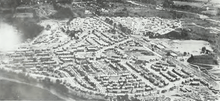Fairview, Camden
| Fairview | |
|---|---|
| Neighborhood of Camden | |
|
A memorial in Fairview, surrounded by residential buildings | |
| Nickname(s): Yorkship Village | |
 Fairview | |
| Coordinates: 39°54′22″N 75°6′21″W / 39.90611°N 75.10583°WCoordinates: 39°54′22″N 75°6′21″W / 39.90611°N 75.10583°W | |
| Country | United States |
| State | New Jersey |
| County | Camden |
| City | Camden |
| Elevation | 20 ft (6 m) |
| Time zone | Eastern (EST) (UTC-5) |
| • Summer (DST) | EDT (UTC-4) |
| ZIP code | 08104 |
| Area code(s) | 856 |
| GNIS feature ID | 0881986[1] |
|
Fairview Historic District | |
 | |
| Location |
Hull Rd and Olympia Rd.; Mount Ephraim Ave.; Crescent Boulevard; North-South Freeway Camden, New Jersey |
|---|---|
| Area | 225 acres (0.91 km2)[2] |
| Built | 1918 |
| Architect | Electus Darwin Litchfield |
| NRHP Reference # | 74001157 |
| NJRHP # | 910[3] |
| Significant dates | |
| Added to NRHP | November 1, 1974 |
| Designated NJRHP | July 1, 1974 |
Fairview, originally called Yorkship Village, is a neighborhood located in the southern part of Camden, New Jersey. According to the 2000 U.S. Census, Fairview has a population of 5,947.[4] Much of the neighborhood is part of a historic district listed on the state and federal registers of historic places.[3]
History
The neighborhood was a federally funded World War I planned community of approximately 1000 homes located near New York Shipbuilding of Camden, New Jersey, and was intended to provide housing for the shipyard's workers and their families.[5] New York Shipbuilding had more than tripled in size due to war contracts, and the influx of shipyard workers was overwhelming the Camden housing market. The United States Shipping Board through its Emergency Fleet Corporation used funds from a $50,000,000 appropriation for housing to alleviate a housing shortage threatening its shipbuilding program.[6] Actual construction was managed by the Department of Housing and Transit, United States Shipping Board, Emergency Fleet Corporation which selected Electus Darwin Litchfield as architect.[7]
The site chosen was just upstream from the shipyard on the South Branch of Newton Creek. The 225-acre (0.91 km2) parcel, then located in Haddon Township, had formerly been the Old Cooper Farmstead. The village's design was influenced by the "garden city" developments popular in England at the time.
Litchfield envisioned Yorkship Village as "a place of light rooms and clean yards, with adequate playgrounds and amusement fields; a place of beauty and appropriateness and cleanliness so great that a man returning from his daily toil would receive new strength and recreation; a place where the man who could save a fraction of his income would be able to obtain with it, for himself and for his children, a share of play and education, literature and music, and other uplifting things."

Litchfield's plan for Yorkship Village included narrow, winding residential streets (soon to be tree-lined), a central village square, broad green boulevards, and brick duplexes and row homes with both front and back yards. Architecturally, the village is now considered an example of American Federal style. The "village" character would be further emphasized by physical isolation, since it was bordered on three sides by Newton Creek.
Construction began with ground-breaking on May 1, 1918. The United States Shipping Board, Emergency Fleet Corporation bore the estimated $11 million cost of construction, but required the local community to provide utilities, fire hydrants, and fire and police protection. The cost of those services was beyond the means of Haddon Township, which ceded Yorkship Village to the City of Camden on July 8, 1918.
At the end of the war the Emergency Fleet Corporation began selling properties with 1,579 housed, 59 apartments, 13 stores, a hotel, a gymnasium and miscellaneous buildings unsold at the start of 1921.[8] By the end of Fiscal Year 1924 all but twelve houses, the sewage system and plant, water system, bridge, public squares and parks had been sold.[9]
It became Camden's 14th Ward. Though Yorkship Village was renamed Fairview in 1922, the original elementary school located near the square is still operating as Yorkship School, and all of the original streets are still named for famous naval vessels.[10]
See also
References
- ↑ "US Board on Geographic Names". United States Geological Survey. 2007-10-25. Retrieved 2008-01-31.
- ↑ http://www.yorkshipvillage.com/article/childs-1918/index.php
- 1 2 "New Jersey and National Registers of Historic Places". New Jersey Department of Environmental Protection - Historic Preservation Office. Retrieved 2013-07-20.
- ↑ "Camden Facts: Fairview". Camconnect.org. Retrieved 2012-02-04.
- ↑ http://www.yorkshipvillage.com/article/litchfield-1919/index.php
- ↑ Warner, Ralph F. (1918). "Yorkship—A New Town for the Emergency Fleet Corporation, near Camden, N.J.". The Architectural Review. Boston: The Architectural Review Company. 6 (June 1918): 91–93. Retrieved 19 August 2015.
- ↑ The Architectural Review (1918). "Government War Housing, Part II". The Architectural Review. Boston: The Architectural Review Company. 6 (June 1918): 94. Retrieved 19 August 2015.
- ↑ United States Shipping Board (1922). Sixth Annual Report of the United States Shipping Board. Washington. Retrieved 19 August 2015.
- ↑ United States Shipping Board (1925). Ninth Annual Report of the United States Shipping Board. Washington. pp. 154–155. Retrieved 19 August 2015.
- ↑ Rachelle Garbarine (2002-01-06). "In the Region/New Jersey; A Plan to Revitalize a Historic Enclave in Camden - New York Times". Fairview (Nj); Camden (Nj): Nytimes.com. Retrieved 2014-06-29.

